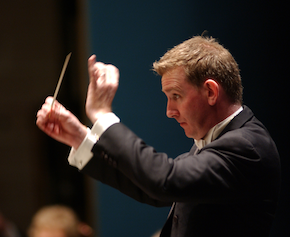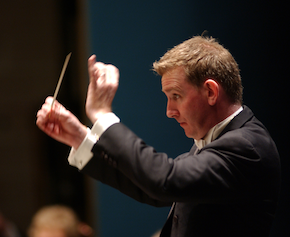
Photo by Terrence McCarthy
A symphonic concert that sports the moniker “Viva Italia” can be nothing other than a sunny, uplifting, and pleasant affair. This was definitely the case at the 60th anniversary season opener of the Marin Symphony on Sunday afternoon. Music Director Alasdair Neale had selected a handful of Italian or Italy-inspired pieces for the occasion: Rossini’s overture to The Barber of Seville, Mendelssohn’s “Italian” Symphony, and Respighi’s Pines of Rome, all guaranteed audience pleasers.
Neale had also invited Bay Area violinist and composer Jeremy Cohen and his Quartet San Francisco (QSF) to contribute something fitting. Against his better judgment, Cohen decided to compose a completely new piece and came up with Concerto Carnevale, for string quartet and orchestra.
The Italian part of the program couldn’t start until after the traditional playing of the national anthem and a brief interlude in which “special guest conductor” Tim Harman — who earned the honor at the Marin Symphony’s fund-raising gala — wielded the baton while the orchestra played a nice arrangement of John Philip Sousa’s march The Stars and Stripes Forever.
In tune with the theme of the concert, the string section already sounded exceptionally Verdi-esque in this most American of marches. Indeed, the Marin Symphony’s orchestral sound was balanced, transparent, and brilliant throughout the concert, with some exceptional solo work from clarinet, bassoons, and piccolos.
The Marin Symphony’s orchestral sound was balanced, transparent, and brilliant throughout.
In spite of Neale’s precise and lucid conducting, the Rossini and especially the Mendelssohn could have benefited from a little more rehearsal to improve accuracy, crispness, and overall togetherness. But I can imagine how preparing for the premiere of Cohen’s Concerto Carnevale and for Respighi’s monumental Pines of Rome interferes with that by eating up precious practice time.
Concerto Carnevale is Cohen’s first large-scale orchestral composition, but his approach is not essentially different than when he composes for QSF, the ensemble that he founded about a decade ago and that currently consists of Matthew Szemela and Cohen himself, violins; Keith Lawrence, viola; and Kelley Maulbetsch, cello. Cohen brings his entire musical experience and background to the task. To him, no walls separate different musical genres, and as a performer he moves with great ease through every musical style.
In his search for “Italian” inspiration he visited his own past, from his upbringing as a Jewish kid in San Francisco to more-recent European vacations — including all the Italian music he played during his career as a violinist. He came to the somewhat startling conclusion that there was a lot to draw from, and he seems to have incorporated an equally startling lot of it in this appealing new piece.
This highly evocative piece echoes the music of film composers like Nino Rota and Carmine Coppola … and it could easily work as a movie score.
The first movement, called “Blue Baroque,” begins with a broad, Baroque-style theme in the quartet. In typical concerto grosso style, the theme bounces from orchestra to quartet in a sort of call and response fashion, but gradually the chord progression acquires more and more jazz and blues features. Cohen uses the quartet and the orchestra as two distinctly different and separated groups, with relatively little overlap, and even though the orchestra part is not always terribly interesting when it’s pure accompaniment, there’s something for everyone in the score, including a nice tuba solo and a few challenging passages for the bassoons.
“Tango,” the second movement, is directly inspired by the work of Argentinian composer (of Italian descent) Astor Piazzolla (1921–1992), and more specifically by his Melodia in A Minor, which “says so much with so little,” according to Cohen. His melody is perhaps less haunting than Piazzolla’s, yet it works very well as an inspired tribute to the great tango master — and also as a bridge to the concerto’s third movement, “Tarantella,” named after an Italian folk dance. This highly evocative piece echoes the music of film composers like Nino Rota and Carmine Coppola (both of Godfather fame), and it could easily work as a movie score. The audience loved it all, and jumped to a standing ovation as soon as the Concerto Carnevale was finished. As an encore, QSF gave the Marin Symphony audience another treat by way of an intense rendering of Grace Slick’s White Rabbit.
Finally, Respighi’s Pines of Rome brought the concert to a brilliant end.

